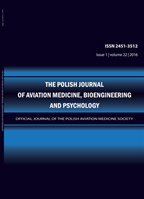2014, Volume 20, Issue 3
Genetic Aspects of Pilots’ Spatial Orientation
Pavel Kovalenko1, Rumyana Kareva2, Daniel Tanev2
-------------------------------------------------------------------------------------------------
1None, Freelance researcher
2Rakovski Defense National Academy
Autor korenspondencyjny: Pavel Kovalenko; None, Freelance researcher; email: pavel.kovalenko.42[at]mail.ru
Full text
Streszczenie
Introduction: The paper presents the results from a study of pilots’ spatial orientation in the civil aviation from genetic point of view. The study addresses the question of whether geocentrics are better suited to become pilots than egocentrics.
Methods: The research was conducted among two groups: group of pilots and group of representatives of other professions. The study was performed in the real flight conditions and laboratory conditions. 300 civil aviation pilots and test-pilots (each with over 5000 flight hours) and 150 non-professionals.
Results and discussion: The results show that the leading type of spatial orientation depends on the conditions in which the persons must make a decision.
Conclusions: There is no evidence supporting the idea that humans genetically fall into two types: egocentrics and geocentrics, according to their dominant type of spatial orientation.
Słowa kluczowe
genetic aspects, spatial orientation in flight, egocentrics, geocentrics
